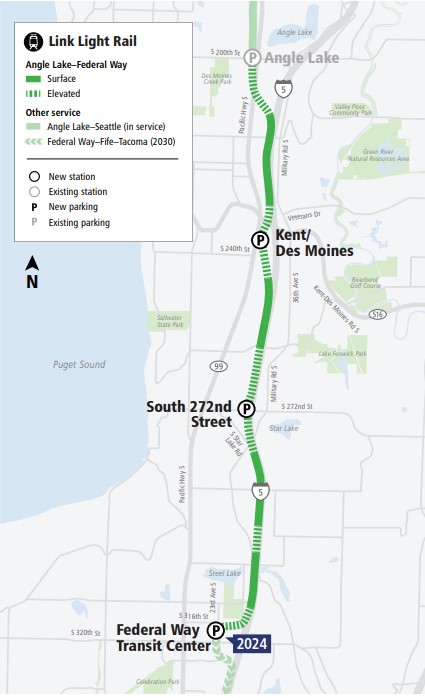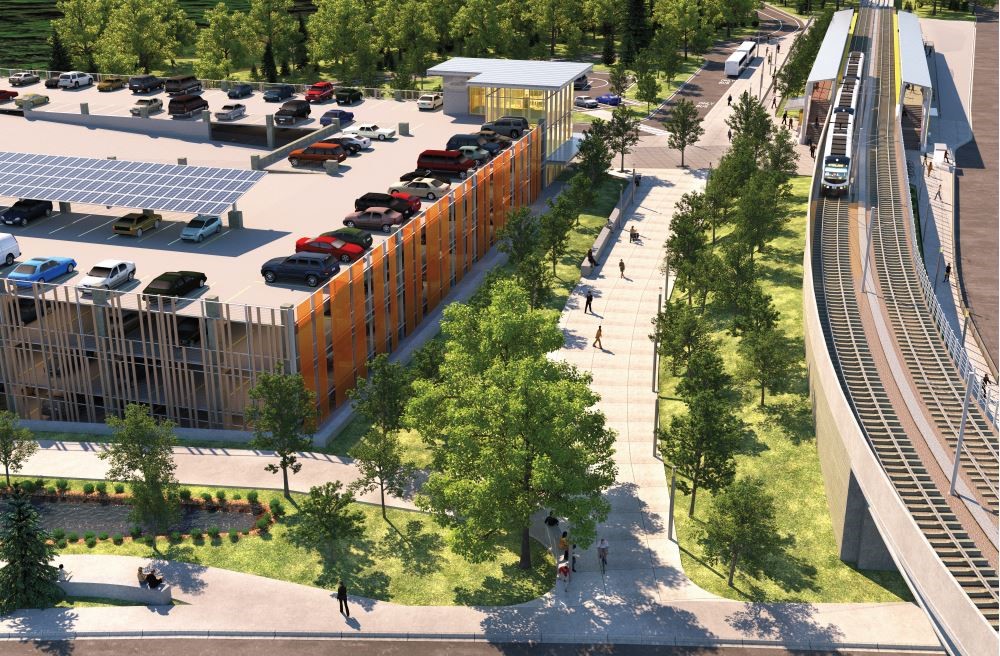
A map of the proposed Federal Way Link Extension
Credit: Sound Transit
| Project Name | Federal Way Link Extension | |
|---|---|---|
| Location | Seattle, WA | |
| Project Sponsor / Borrower | Sound Transit | |
| Program Areas | ||
| Value Capture Techniques | Special Assessment (Sales Tax Districts) | |
| Mode | Commuter Rail Transit, Intermodal Transit, Light Rail Transit, Parking, Pedestrian / Bicycle / Light Rail Transit | |
| Description | Currently under construction by the Central Puget Sound Regional Transit Authority (Sound Transit), the Federal Way Link Extension project will extend a 7.8-mile light rail transit line from the existing Angle Lake Station, south to the Federal Way Transit Center. The project will also extend to a terminal at a temporary maintenance facility for vehicle inspection and interior cleaning at the south end of the tail track. The expansion will operate as the southernmost segment of Sound Transit’s north-south light rail line and offer connections to numerous local and regional bus lines. It will provide a one-seat ride from South King County to the Seattle-Tacoma International Airport, Downtown Seattle, University of Washington, Northgate, and points north of Lynnwood. The project also includes the purchase of 20 light rail vehicles (LRVs) and will provide the track work and train-operating systems for the LRVs that are electrically powered using an overhead contact wire and a 1,500-volt traction power supply system. Fares will be off-board and will utilize a proof-of-payment system. The link extension will include three new stations at Kent Des Moines Road, South 272nd Street, and the Federal Way Transit Center. Each will include a light rail platform and canopy, surrounding plaza, parking garage, bike storage, passenger drop-off facility, short-term parking, and a service building. They will have 500, 1,200, and 400 parking spaces respectively. The project will serve population, employment, and education centers and provide other opportunities for development. It will operate in an exclusive right-of-way and parallel to SR 99 and Interstate 5 on an elevated or at-grade alignment. The project is expected to relieve congestion, improve transit performance, and enhance mobility along a busy portion of southern King County. Once completed, service is planned to operate 20 hours on weekdays and 18 hours on weekends. It will be provided from 5 a.m. to 1 a.m. on weekdays and 6 a.m. to midnight on weekends. Trains are scheduled to arrive every eight minutes during weekday peak periods and every 10 minutes during off-peak periods and on weekends. |
|
| Cost | $3.16 billion. The total capital cost ($YOE) is $3,160.70M and its estimated annual operating cost will be $20.37M |
|
| Funding Sources |
|
|
| Project Delivery / Contract Method | Design-Build | |
| Private Partner |
|
|
| Project Advisors / Consultants |
|
|
| Lenders | U.S. Department of Transportation | |
| Duration / Status |
In January 2017, the Sound Transit board selected the final route and station locations, extending light rail service south from SeaTac’s station to Federal Way. Also, in 2017, the Sound Transit board selected the final route and stations, and finalized agreements with partner cities. The project’s status is currently in the pre-construction phase with expectations of completion in 2024. |
|
| Financial Status/Financial Performance | To date, the project has secured more than $1.4B with a $629.5M TIFIA loan from the U.S. Department of Transportation and a $790M grant from the Federal Transit Authority. TIFIA Credit Agreement signed in December 2019 (Thu, 12/19/2019 - 12:00). The TIFIA loan will be repaid with voter approve taxes (sales/use, rental car, and motor vehicle taxes). |
|
| Innovations |
|
|
| Related Links / Articles | ||
| Contact | Name | Jefferson Rose |
| Title | Community Outreach South Corridor Manager | |
| Phone # | (206) 370-5568 | |
| fwle@soundtransit.org | ||

A rendering of possible typical conditions at the S 272nd Street station area that will run alongside a new parking garage with solar panels. (Credit: Sound Transit)